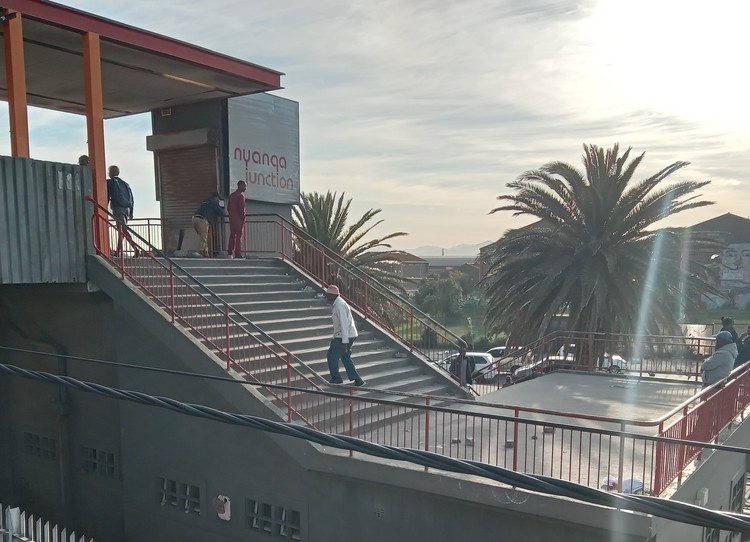Many Cape Town stations are closed to wheelchair users
And the “People’s Train” is inaccessible to many people
Nyanga Junction station, with stairs and no working lift, is inaccessible to wheelchair users. Photos: Sandiso Phaliso
- Wheelchair users do not have access to many stations in Cape Town.
- Some have stairs without ramps or lifts; others have lifts which do not work.
- At Nyanga Junction, lifts have not worked since at least 2019.
- The new blue trains are inaccessible to wheelchair users, and difficult to access to many other commuters, because the train is higher than the platform.
Many train stations in Cape Town are inaccessible to commuters with disabilities, and difficult for the elderly and children, as there are no ramps, and lifts are broken.
Moreover, the blue-coloured trains, dubbed “People’s Trains”, are higher than the platform, making it difficult to board for many people and impossible to board without help for people using wheelchairs. People in wheelchairs have to ask other passengers for help getting on and off the train.
At Nyanga Junction, there are stairs, then a short ramp, then several dozen stairs to the top. The station does have lifts but they do not work. And even if the lifts did work, people in wheelchairs would have to ask other passengers to carry them up and down several steps to the lift.
At several stations, including Wynberg, Observatory and Stuurhof, the subway and bridges are not accessible to people in wheelchairs.
At Lentegeur and Mandalay train stations, the lifts have not operated for years.
Transport advocacy group #UnitedBehind has urged the Passenger Rail Agency of South Africa (PRASA) to fast track its plans and make the stations and the blue trains disabled-friendly.
The new blue trains are much higher than the platforms, making access impossible for wheelchair users without help.
#UniteBehind told GroundUp it had recently conducted a review of PRASA’s capacity to accommodate people living with disabilities and found that most train stations were entirely inaccessible for people using wheelchairs or other mobility assistance.
Joseph Mayson, legal officer at #UniteBehind said lifts intended to assist people to access stations with multiple levels “do not work or are non-existent”.
Mayson said the blue trains do have spaces inside allocated for wheelchairs “but there is no way for people with wheelchairs to enter the train”.
“This is because the new train’ entrances are significantly higher than our station platforms,” said Mayson. “When asked how people needing mobility assistance can enter the trains, PRASA’s response has been that security guards posted on stations will pick people up and put them in the trains. This is an entirely unworkable situation.”
“PRASA will need to modify its stations to make them accessible for people living with disabilities. It is shameful that PRASA has disregarded the needs of our most vulnerable citizens,” said Mayson.
PRASA is violating the Transport Act which stipulates the protection of people with disabilities, said #UniteBehind’s Phelisa Ndlangamandla.
“People with disabilities should enjoy equal rights as other commuters without discrimination,” said Ndlangamandla.
PRASA spokesperson Andiswa Makanda confirmed that most lifts do not work. She told GroundUp there are a total of 99 lifts in train stations across the country, of which 38 are in the Western Cape, and of the 38 lifts only 13 are operational.
She blamed the lack of accessibility to destruction and vandalism of stations between 2019 and 2021.
But the lifts at Nyanga Junction station were already out of order in November 2019, leaving the station inaccessible to wheelchair users.
Makanda said PRASA is currently conducting an audit of all its stations for compliance with universal accessibility.
With regard to Lentegeur train station, Makanda said lift upgrades were underway and the lifts should be operational by the end of March 2025. At Mandalay station, said Makanda, the lifts should be operational by the end of June 2025.
The lift at Nyanga Junction is boarded up, one of many station lifts which have not worked for years.
Support independent journalism
Donate using Payfast

Next: Why do potholes occur?
Previous: Hundreds of drug users stranded after Gauteng government closes rehabs
Letters
© 2024 GroundUp. This article is licensed under a Creative Commons Attribution-NoDerivatives 4.0 International License.
You may republish this article, so long as you credit the authors and GroundUp, and do not change the text. Please include a link back to the original article.
We put an invisible pixel in the article so that we can count traffic to republishers. All analytics tools are solely on our servers. We do not give our logs to any third party. Logs are deleted after two weeks. We do not use any IP address identifying information except to count regional traffic. We are solely interested in counting hits, not tracking users. If you republish, please do not delete the invisible pixel.



